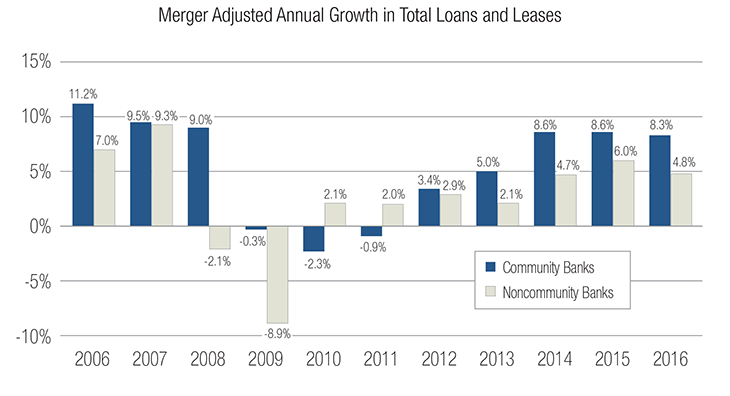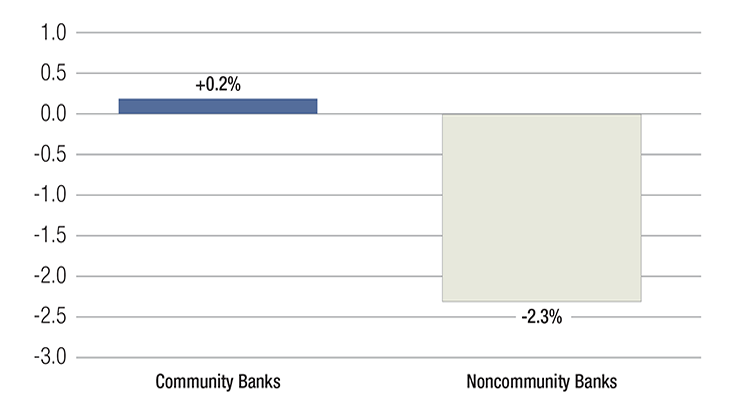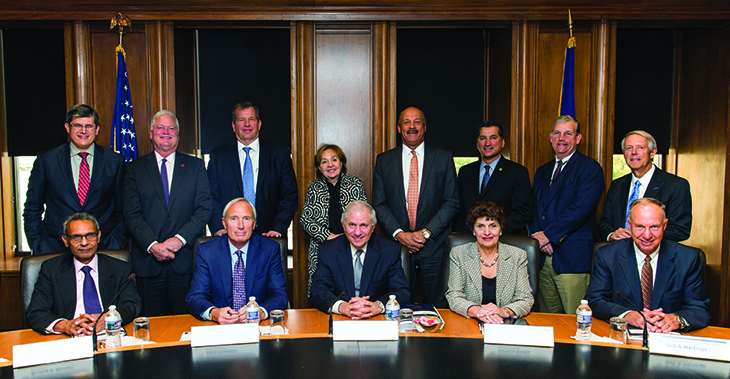2017 Annual Report
I. Management’s Discussion and Analysis
The Year in Review
COMMUNITY BANKING INITIATIVEs
Community banks provide traditional, relationship-based banking services in their local communities. As defined in FDIC research, community banks comprised 92 percent of all FDIC-insured institutions as of September 2017. While they hold just 13 percent of banking industry assets, community banks are of critical importance to the U.S. economy and local communities across the nation. Community banks hold 43 percent of the industry’s small loans to farms and businesses, making them the lifeline to entrepreneurs and small enterprises of all types. They also hold the majority of bank deposits in U.S. rural counties and micropolitan counties with populations up to 50,000. In fact, as of June 2017, community banks held more than 75 percent of deposits in almost 1,200 U.S. counties. In 625 of these counties, the only banking offices available to consumers were those operated by community banks.
The FDIC is the primary federal supervisor for the majority of community banks, in addition to being the insurer of deposits held by all U.S. banks and thrifts. Accordingly, the FDIC has a particular responsibility for the safety and soundness of community banks and for communicating the role they play in the banking system. In 2012, the FDIC launched a Community Banking Initiative focused on publishing new research on issues of importance to community banks and providing resources that will be useful to their efforts to manage risks, enhance the expertise of their staff, and better understand changes in the regulatory environment.
Community Banking Research
The FDIC continues to pursue an agenda of research and outreach focused on community banking issues. Since the 2012 publication of the FDIC Community Banking Study, FDIC researchers have published more than a dozen additional studies on topics ranging from small business financing to the factors that have driven industry consolidation over the past 30 years. The Community Bank Performance Section of the FDIC Quarterly Banking Profile (QBP), first introduced in 2014, continues to provide a detailed statistical picture of the community banking sector that can be accessed by analysts, other regulators, and bankers themselves. The most recent report shows that net income at community banks continued to grow at a healthy annual rate through September 2017, despite the headwinds associated with narrow net interest margins.
The long-term trend of consolidation continues at both community and noncommunity banks. However, this trend has done little to diminish the role of community banks in the banking industry. More than two-thirds of the community banks that merged in 2017 were acquired by other community banks. On a merger-adjusted basis, loan growth at community banks exceeded growth at noncommunity banks in every year between 2012 and 2016. (See Chart 1)
On this same basis, the number of banking offices operated by community banks increased slightly in the year ending in June 2017, while offices operated by noncommunity banks declined. (See Chart 2)
CHART 1: COMMUNITY BANK LOAN GROWTH
HAS EXCEEDED GROWTH
At NONCOMMUNITY BANKS FOR FIVE CONSECUTIVE YEARS

CHART 2: PERCENT GROWTH IN TOTAL BANKING OFFICES
June 2015-June 2016
 Source: FDIC. All calculations are merger adjusted.
Source: FDIC. All calculations are merger adjusted.
Community Bank Advisory Committee
The FDIC’s Advisory Committee on Community Banking is an ongoing forum for discussing current issues and receiving valuable feedback from the industry. The committee, which met three times during 2017, is composed of chief executive officers of 13 community banks from around the country. It is a valuable resource for input on a wide variety of topics, including examination policies and procedures, capital and other supervisory issues, credit and lending practices, deposit insurance assessments and coverage, and regulatory compliance issues. At the June 2017 meeting, the Division of Insurance and Research (DIR) presented a range of performance and growth comparisons between community and noncommunity banks dating back to 2006. These results showed that merger-adjusted total loan growth at community banks exceeded 8 percent in 2014, 2015, and 2016, outpacing nominal U.S. Gross Domestic Product growth in all three years.

De Novo Banks
The FDIC continued multiple initiatives in fulfilling its commitment to working with, and providing support to, any group with interest in starting a bank. In general, these initiatives focused on reviewing and, as appropriate, updating the processes, procedures, and management systems by which the FDIC receives, reviews, and acts on applications. Key elements of these initiatives with respect to deposit insurance applications included completing outreach meetings, issuing a handbook for organizers, and issuing updated procedures. Specifically, the FDIC has:
- Continued to hold industry outreach meetings, which began in 2016. The meetings were designed to ensure industry participants are well informed about the FDIC’s application process and are aware of the tools and resources available to assist organizing groups. Outreach meetings have been held in each FDIC Regional Office.
- Issued in final form a publication entitled, “Applying for Deposit Insurance – A Handbook for Organizers of De Novo Institutions.” The handbook was issued for public comment in December 2016 to help organizers become familiar with the deposit insurance application process and to describe the path to obtaining deposit insurance. This publication serves as a guide for organizing groups and incorporates lessons shared by organizing officials of de novo institutions during the FDIC’s outreach events. The publication also addresses the timeframes within which applicants may expect communication from the FDIC regarding the application review process.
- Issued an updated deposit insurance procedures manual for public comment. The manual provides comprehensive guidance to staff regarding the deposit insurance application process and addresses topics such as pre-filing activities, application review and acceptance, application processing, pre-opening activities, and post-opening considerations, among other important items.
Technical Assistance Program
As part of the Community Banking Initiative, the FDIC continued to provide a robust technical assistance program for bank directors, officers, and employees. The technical assistance program includes Directors’ College events held across the country, industry teleconferences and webinars, and a video program.
In 2017, the FDIC hosted Directors’ College events in each of its six regions. These events were typically conducted jointly with state trade associations and addressed issues such as corporate governance, regulatory capital, community banking, concentrations management, consumer protection, BSA, and interest-rate risk, among other topics.
The FDIC offers a series of banker events, intended to maintain open lines of communication and to keep bank management and staff up-to-date on important banking regulatory and emerging issues of interest to community bankers. In 2017, the FDIC offered 15 teleconferences or webinars focused on the following topics:
- Home Mortgage Disclosure Act (HMDA) Implementation;
- Understanding your Reasonably Expected Market Area (REMA) and CRA Assessment Area;
- CRA Best Practices for Addressing Identified Weaknesses and Documenting Community Development Activities;
- Small Business Resources for Community Banks;
- Financial Education and Financial Empowerment Resources that Support People with Disabilities;
- Affordable Mortgage Lending;
- Liquidity and Funding Risk Management;
- Proposed Simplifications to the Capital Rule Pursuant to the Economic Growth and Regulatory Paperwork Reduction Act of 1996;
- Revisions to the Consolidated Reports of Condition and Income (Call Report);
- Current Expected Credit Losses (CECL) Methodology; and
- An update on Risk Management – Bank Secrecy Act.
In November 2017, the FDIC participated in an interagency webinar focused on fair lending hot topics. Additionally, the FDIC offered three deposit insurance coverage seminars for bank officers and employees in 2017. These free seminars, which were offered nationwide, particularly benefitted smaller institutions that have limited training resources. The FDIC also released three deposit insurance seminar training videos on the FDIC’s website and YouTube channel.
Economic Growth and Regulatory Paperwork Reduction Act
In March 2017, the FFIEC submitted a report to Congress pursuant to the Economic Growth and Regulatory Paperwork Reduction Act (EGRPRA). The report was prepared by the federal banking agencies and NCUA. Under EGRPRA, the federal banking agencies and the FFIEC are directed to conduct a joint review of regulations every ten years to determine whether any of those regulations are outdated or unnecessary.
Over the course of two years, the agencies published a series of Federal Register notices, providing industry participants, consumer and community groups, and other interested parties an opportunity to identify regulatory requirements they believe are no longer needed or should be modified. The agencies also held six public outreach meetings across the country to provide an opportunity for bankers, consumer and community groups, and other interested persons to present their views on any of the regulations subject to EGRPRA review. A total of 234 comment letters were received directly in response to the Federal Register notices, as well as additional oral and written comments from panelists and the public at the outreach meetings. These comments formed the basis of the report that was submitted to Congress in March 2017.
The EGRPRA report described actions the agencies had already taken to address comments received during the EGRPRA process as well as actions the agencies planned to take in the future. During 2017, the FDIC along with the other FFIEC member agencies, worked together to reduce burden in the following significant areas raised during the EGRPRA reviews:
Community Bank Call Report
- During 2017, the FDIC and the other members of the FFIEC continued their initiative, launched in December 2014, to identify potential opportunities to reduce the burden associated with Call Report requirements for community banks. Effective as of the March 31, 2017 report date, a new streamlined FFIEC 051
Call Report was implemented for eligible small institutions. In general, eligible small institutions are institutions with domestic offices only and total assets of less than $1 billion. This new report removed approximately 950, or about 40 percent, of the nearly 2,400 data items that had been included in the FFIEC 041 Call Report applicable to all institutions with domestic offices only, and reduced the reporting frequency for approximately 100 additional data items. An eligible small institution is not required to file the FFIEC 051 report, but has the option to continue filing the FFIEC 041 report. Of the approximately 5,000 eligible small institutions, more than 70 percent have elected to submit the FFIEC 051 report. Certain burden-reducing changes also were made to the existing FFIEC 031 Call Report for institutions with domestic and foreign offices and the FFIEC 041 report effective March 31, 2017.
On June 27, 2017, and on November 8, 2017, the banking agencies proposed additional burden-reducing revisions to all three versions of the Call Report. On January 3, 2018, the FFIEC announced the finalization of the June 2017 proposal. These proposals resulted from the FFIEC’s ongoing efforts to ease reporting requirements and lessen reporting burden that are focused on, but not limited to, small institutions. These revisions are scheduled to take effect June 30, 2018.
- During 2017, the FDIC and the other members of the FFIEC continued their initiative, launched in December 2014, to identify potential opportunities to reduce the burden associated with Call Report requirements for community banks. Effective as of the March 31, 2017 report date, a new streamlined FFIEC 051
Call Report was implemented for eligible small institutions. In general, eligible small institutions are institutions with domestic offices only and total assets of less than $1 billion. This new report removed approximately 950, or about 40 percent, of the nearly 2,400 data items that had been included in the FFIEC 041 Call Report applicable to all institutions with domestic offices only, and reduced the reporting frequency for approximately 100 additional data items. An eligible small institution is not required to file the FFIEC 051 report, but has the option to continue filing the FFIEC 041 report. Of the approximately 5,000 eligible small institutions, more than 70 percent have elected to submit the FFIEC 051 report. Certain burden-reducing changes also were made to the existing FFIEC 031 Call Report for institutions with domestic and foreign offices and the FFIEC 041 report effective March 31, 2017.
Advisory on the Availability of Appraisers
- The FDIC, FRB, OCC, and NCUA issued an advisory that discusses two existing methods that may address appraiser shortages, particularly in rural areas: temporary practice permits and temporary waivers. The advisory addresses concerns raised pursuant to the EGRPRA review process.
The first method, temporary practice permits, may be granted by state appraiser regulatory agencies to allow credentialed appraisers to provide their services in states experiencing a shortage of appraisers, subject to state law. Reciprocity is a widely used practice in which one state recognizes the appraiser certification and licensing of another state, permitting state-certified and -licensed appraisers to perform appraisals across state lines. The second method, temporary waivers, sets aside requirements relating to the certification or licensing of individuals to perform appraisals under Title XI of FIRREA in states or geographic political subdivisions while there is a scarcity of certified or licensed appraisers that has caused significant delays in performing appraisals. Authority to grant temporary waiver requests rests with the Appraisal Subcommittee, and is subject to FFIEC approval. To further communicate about the availability of the waiver process and get a deeper understanding of rural appraisal issues, the Conference of State Bank Supervisors organization arranged six roundtables between federal banking regulators, state commissioners and rural community bankers. Roundtables were held in Michigan, Tennessee, Wyoming, North Dakota, South Dakota, and Montana.
- The FDIC, FRB, OCC, and NCUA issued an advisory that discusses two existing methods that may address appraiser shortages, particularly in rural areas: temporary practice permits and temporary waivers. The advisory addresses concerns raised pursuant to the EGRPRA review process.
Commercial Real Estate Appraisal Threshold
- The FDIC, FRB, and OCC jointly issued an Notice of Proposed Rulemaking (NPR) entitled Real Estate Appraisals that was published in the Federal Register for a 60-day comment period, which ended on September 29, 2017. The NPR creates a new definition of, and separate category for, commercial real estate (CRE) transactions and proposes to increase the current appraisal threshold for CRE transactions from $250,000 to $400,000. For CRE transactions at or below the proposed threshold, the interagency appraisal regulations require financial institutions to obtain an appropriate evaluation of the real property collateral that is consistent with safe and sound banking practices, but such an evaluation does not need to be performed by a licensed or certified appraiser or meet the other Title XI appraisal standards. The agencies are in the process of reviewing the comments.
Expanded Examination Cycle
- The FDIC, FRB, and OCC jointly adopted
as final – and without change – the interim final rules that expanded the examination cycle for certain small IDIs and U.S. branches and agencies of foreign banks. The final rules were published in the Federal Register on December 16, 2016. Section 83001 of the Fixing America’s Surface Transportation Act raised the threshold for the 18-month examination cycle from less than $500 million to less than $1 billion for certain well-capitalized and well-managed IDIs with an “outstanding” composite condition, and gave the agencies discretion to similarly raise this threshold for certain IDIs with an “outstanding” or “good” composite condition. The agencies exercised this discretion and issued an interim final rule that, in general, makes qualifying IDIs with less than $1 billion in total assets eligible for an 18-month (rather than a 12-month) examination cycle. The rules allow IDIs with up to $1 billion in total assets, and that meet certain other criteria, to qualify for an 18-month on-site examination cycle. To qualify, IDIs must have a CAMELS composite rating of “1” or “2,” must be well-capitalized, well-managed, must not be subject to a formal enforcement proceeding, and must not have undergone any change in control during the previous 12-month period. The rule also applies to qualifying U.S. branches or agencies of a foreign bank. As a result of this new rule, the FDIC rescinded and removed a transferred Office of Thrift Supervision (OTS) Regulation, 12 CFR 390.351, Frequency of Safety and Soundness Examinations, because it was redundant.
Since BSA compliance programs are typically reviewed during safety and soundness examinations, institutions with assets between $500 million and $1 billion that are now eligible for a safety and soundness examination every 18-months will also generally be subject to less frequent BSA reviews.
- The FDIC, FRB, and OCC jointly adopted
as final – and without change – the interim final rules that expanded the examination cycle for certain small IDIs and U.S. branches and agencies of foreign banks. The final rules were published in the Federal Register on December 16, 2016. Section 83001 of the Fixing America’s Surface Transportation Act raised the threshold for the 18-month examination cycle from less than $500 million to less than $1 billion for certain well-capitalized and well-managed IDIs with an “outstanding” composite condition, and gave the agencies discretion to similarly raise this threshold for certain IDIs with an “outstanding” or “good” composite condition. The agencies exercised this discretion and issued an interim final rule that, in general, makes qualifying IDIs with less than $1 billion in total assets eligible for an 18-month (rather than a 12-month) examination cycle. The rules allow IDIs with up to $1 billion in total assets, and that meet certain other criteria, to qualify for an 18-month on-site examination cycle. To qualify, IDIs must have a CAMELS composite rating of “1” or “2,” must be well-capitalized, well-managed, must not be subject to a formal enforcement proceeding, and must not have undergone any change in control during the previous 12-month period. The rule also applies to qualifying U.S. branches or agencies of a foreign bank. As a result of this new rule, the FDIC rescinded and removed a transferred Office of Thrift Supervision (OTS) Regulation, 12 CFR 390.351, Frequency of Safety and Soundness Examinations, because it was redundant.
Extension of Capital Rule Transitions
- In August 2017, the FDIC, FRB, and OCC proposed revisions to the regulatory capital rules to pause the phase-in of certain regulatory capital adjustments and deductions that are part of the Basel III capital standard. Specifically, the agencies proposed to maintain on an ongoing basis the transition treatment effective for calendar year 2017 for items subject to the 10 and 15 percent common equity tier one capital deduction thresholds, and surplus minority interest. The proposal applied to all non-advanced approaches banking organizations that are subject to the risk-based capital rules. The federal banking agencies finalized the proposed rule in November 2017.
EGRPRA Capital Proposal
- In September 2017, the FDIC issued an NPR addressing industry feedback regarding simplification of the capital rules for small banks generally, and to clarify the existing definition of high-volatility commercial real estate. In addition, the proposed simplifications include changes to the regulatory capital treatment of mortgage servicing assets, deferred tax assets, investments in the capital instruments of other financial institutions, and minority interest.
Additionally, recognizing that regulatory burden does not emanate only from statutes and regulations, the FDIC, along with the FFIEC and its members, have initiated the FFIEC Examination Modernization project as a follow up to the review of regulations under EGRPRA. The Modernization project is focused on ways to improve the efficiency of processes, procedures, and tools related to examinations and supervisory oversight of the safety and soundness examination processes, while maintaining the quality of the process. There are three parts to the project:
- Reviewing examination practices and processes with a particular goal of determining whether technology can be used to make existing examination activities more efficient or allow for additional safety and soundness examination work to be conducted off-site.
- Reviewing the format of the examination report itself and determining whether there are opportunities to improve the quality and usefulness of reports.
- Reviewing the Uniform Bank Performance Report (UBPR) and related reports and data to determine if there are ways to make them more informative, useful, and user friendly. In particular, the agencies are working to provide the ability to generate graphs and charts of key ratios.
In 2017, the Examination Modernization Project’s staff met regularly to compare FFIEC agency practices and develop recommendations for the FFIEC’s consideration.

